Abstract
1. The interaction of insulin and isometric exercise on glucose uptake by skeletal muscle was studied in the isolated perfused rat hindquarter. 2. Insulin, 10 m-i.u./ml, added to the perfusate, increased glucose uptake more than 10-fold, from 0.3-0.5 to 5.2-5.4 mumol/min per 30g of muscle in hindquarters of fed and 48h-starved rats respectively. In contrast, it did not stimulate glucose uptake in hindquarters from rats in diabetic ketoacidosis. 3. In the absence of added insulin, isometric exercise, induced by sciatic-nerve stimulation, increased glucose uptake to 4 and 3.4 mumol/min per 30g of muscle in fed and starved rats respectively. It had a similar effect in rats with moderately severe diabetes, but it did not increase glucose uptake in rats with diabetic ketoacidosis or in hindquarters of fed rats that had been "washed out" with an insulin-free perfusate. Insulin, at concentrations which did not stimulate glucose uptake in resting muscle, restored the stimulatory effect of exercise in these situations. 4. The stimulation of glucose uptake by exercise was independent of blood flow and the degree of tissue hypoxia; also it could not be reproduced by perfusing resting muscle with a medium previously used in an exercise experiment. 5. At rest glucose was not detectable in muscle cell water of fed and starved rats even when perfused with insulin. In the presence of insulin, a small accumulation of glucose, 0.25 mM, was noted in the muscle of ketoacidotic diabetic rats, suggesting inhibition of glucose phosphorylation, as well as of transport. 6. During exercise, the calculated intracellular concentration of glucose in the contracting muscle increased to 1.1-1.6mM in the fed, starved and moderately diabetic groups. Insulin significantly increased the already high rates of glucose uptake by the hindquarters of these animals but it did not alter the elevated intracellular concentration of glucose. 7. In severely diabetic rats, exercise did not cause glucose to accumulate in the cell in the absence of insulin. In the presence of insulin, it increased glucose uptake to 6.1 mumol/min per 30g of muscle and intracellular glucose to 0.72 mM. 8. The data indicate that the stimulatory effect of exercise on glucose uptake requires the presence of insulin. They suggest that in the absence of insulin, glucose uptake is not enhanced by exercise owing to inhibition of glucose transport into the cell.
Full text
PDF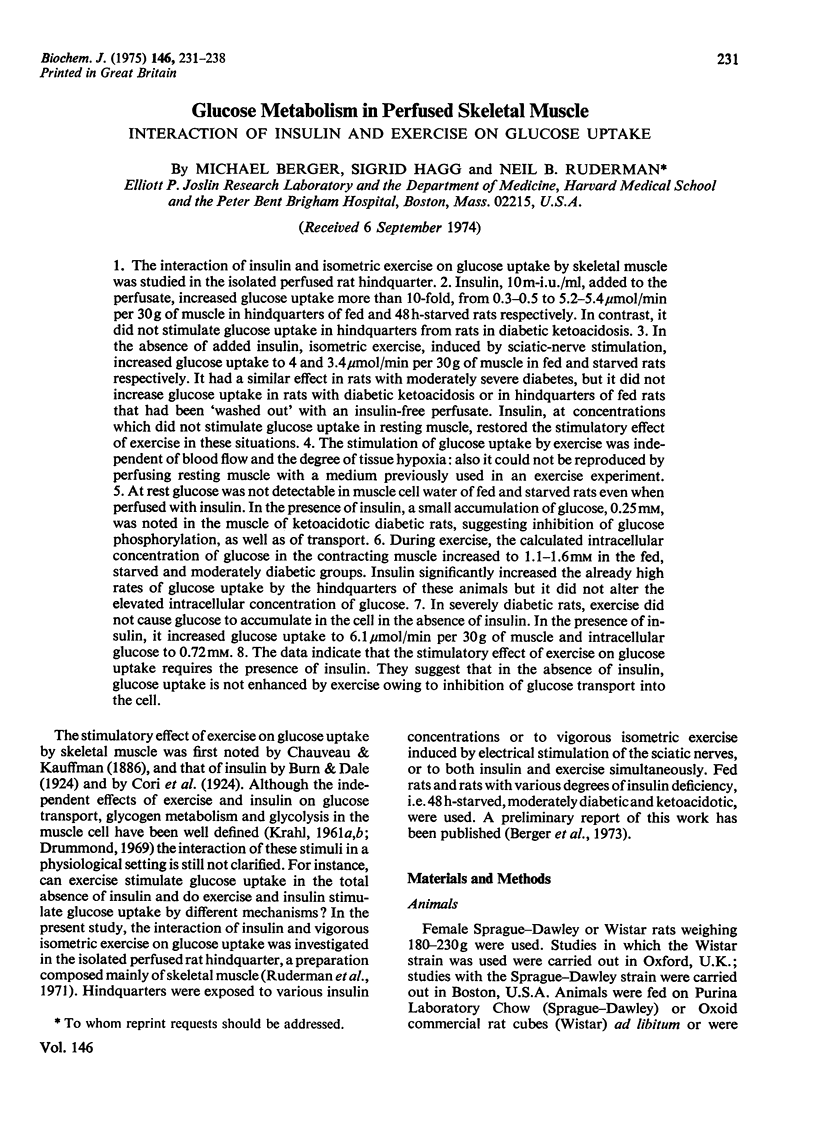
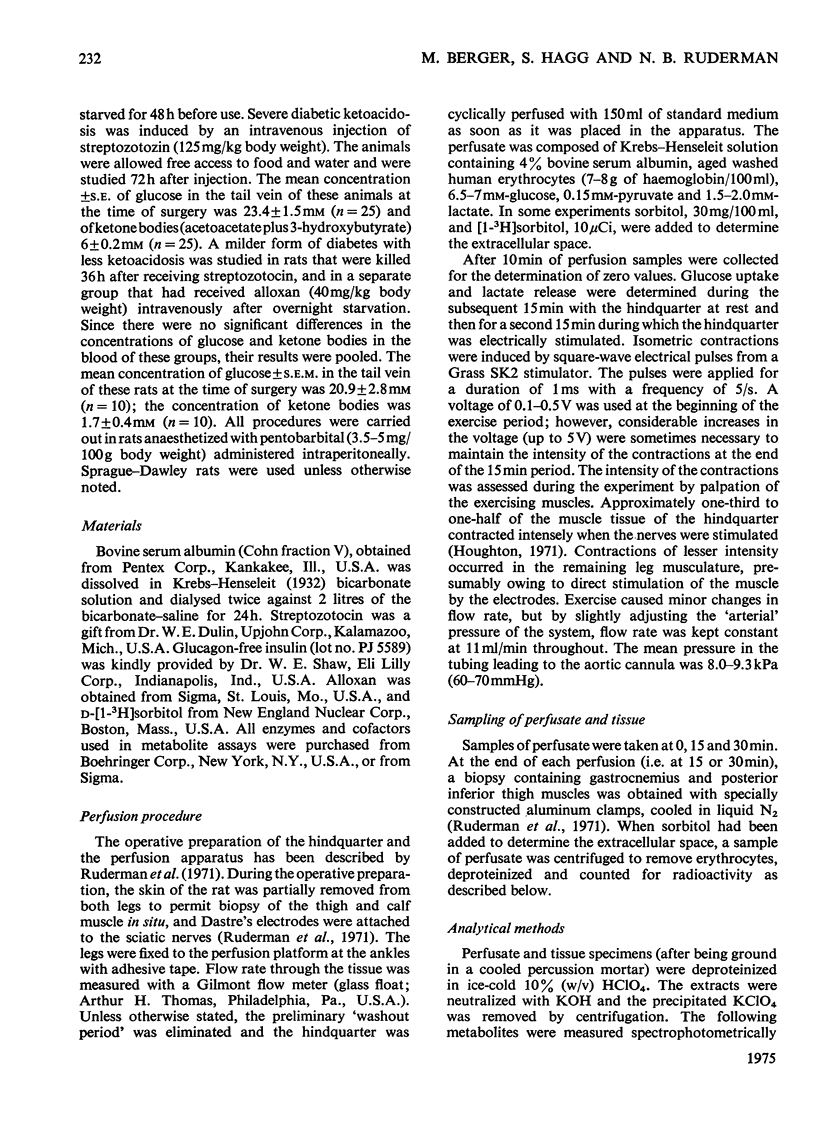
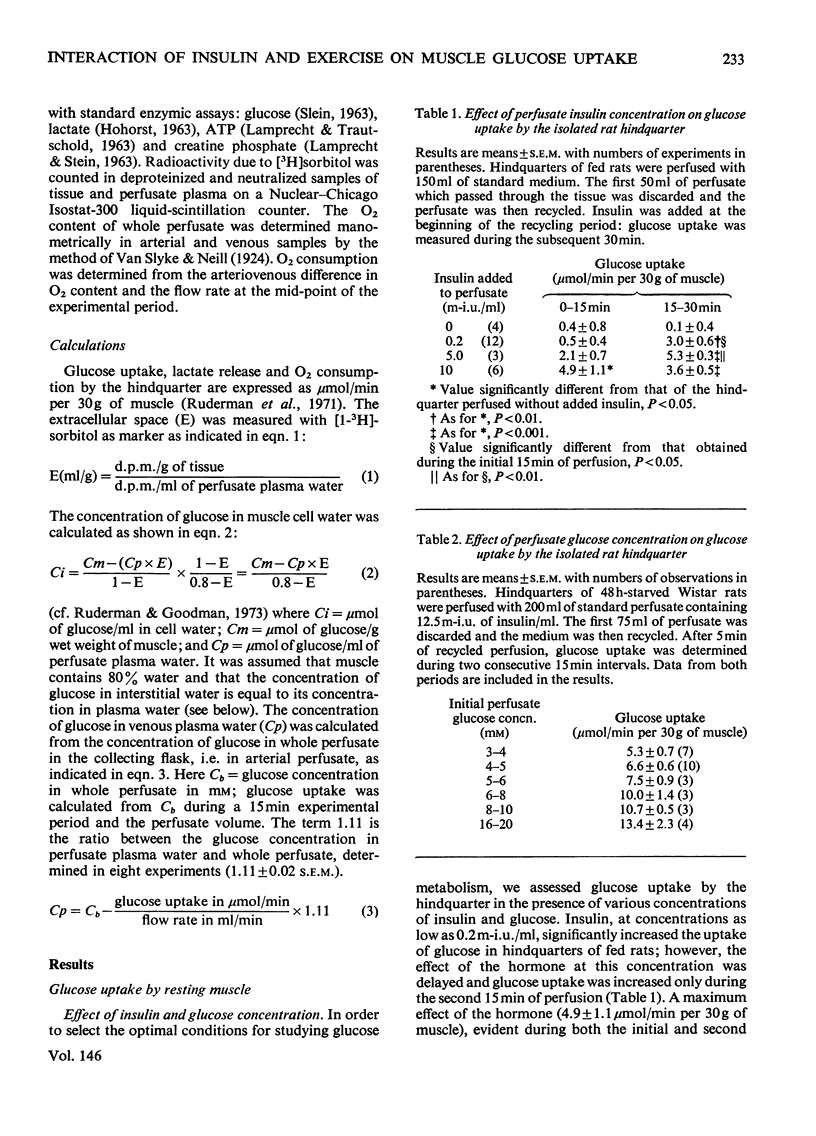
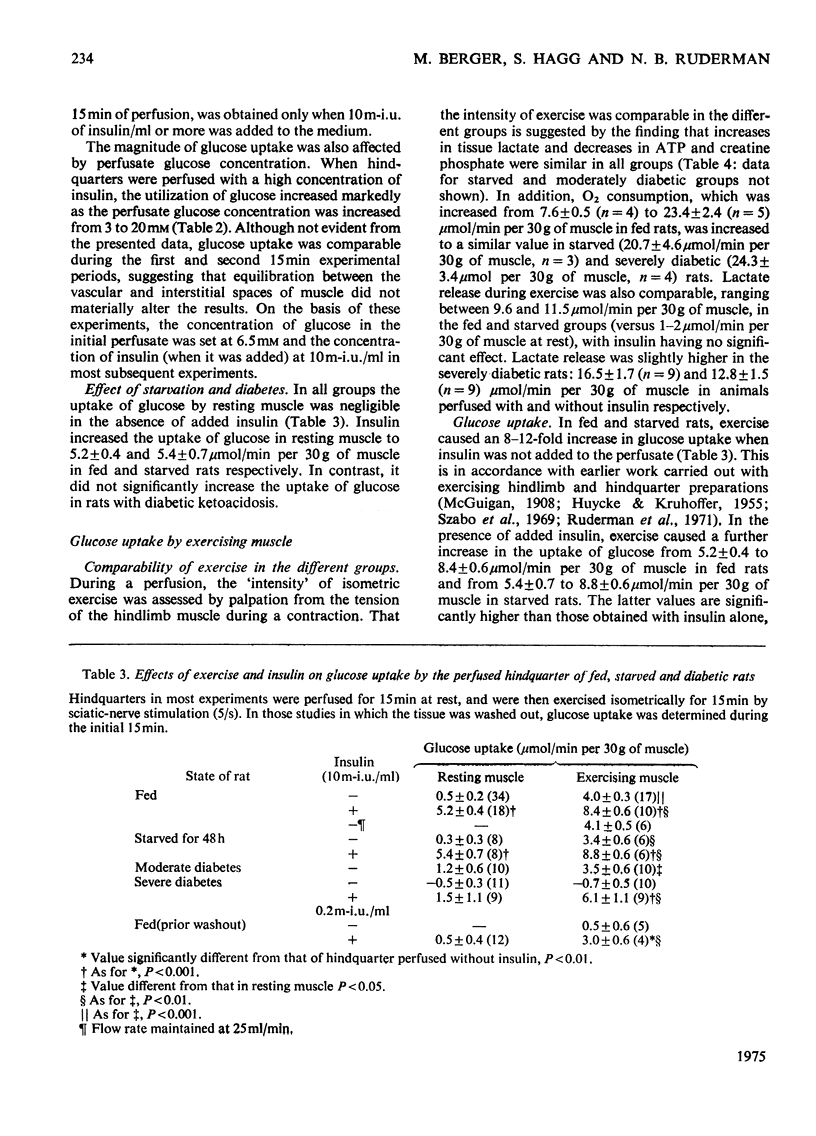
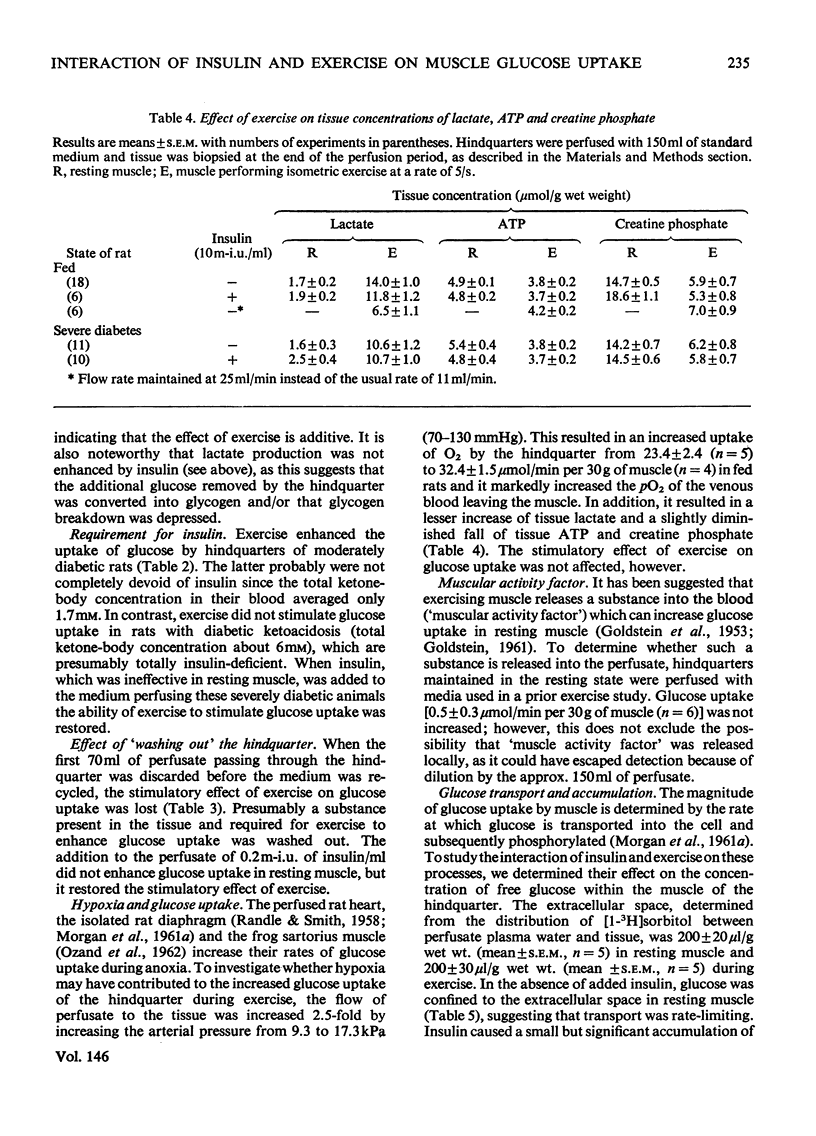
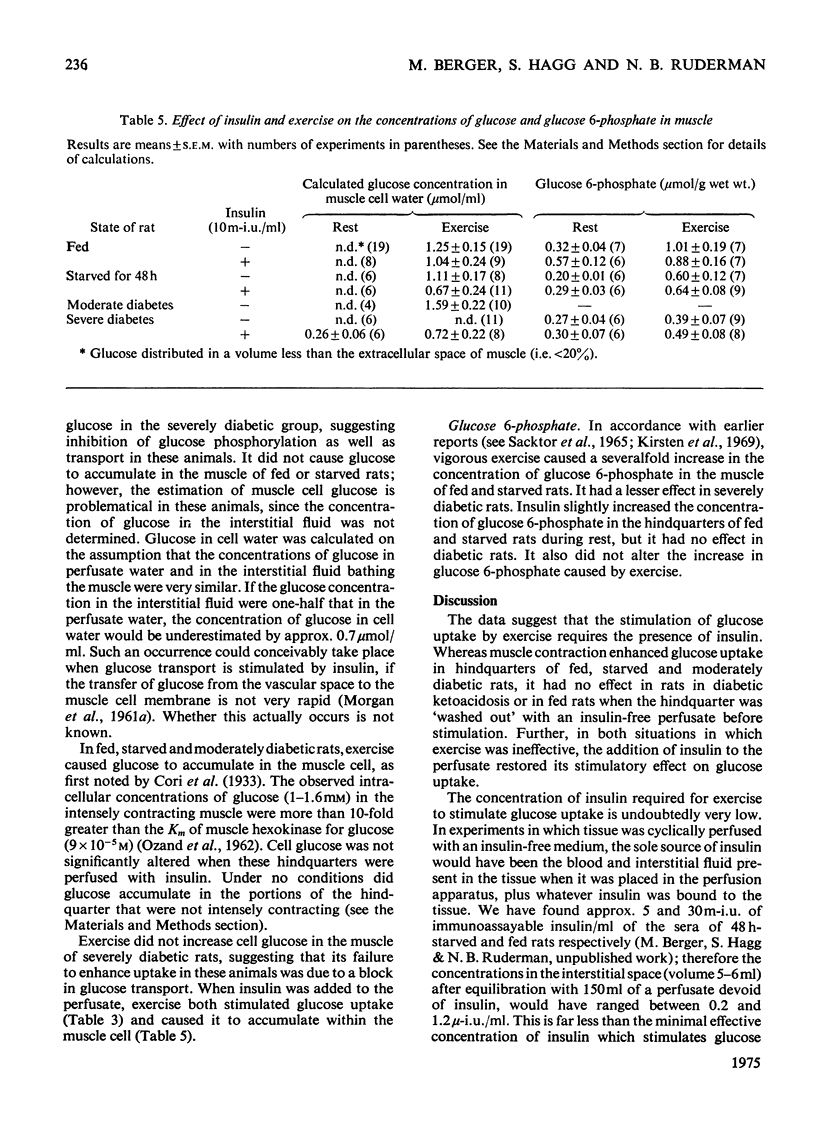
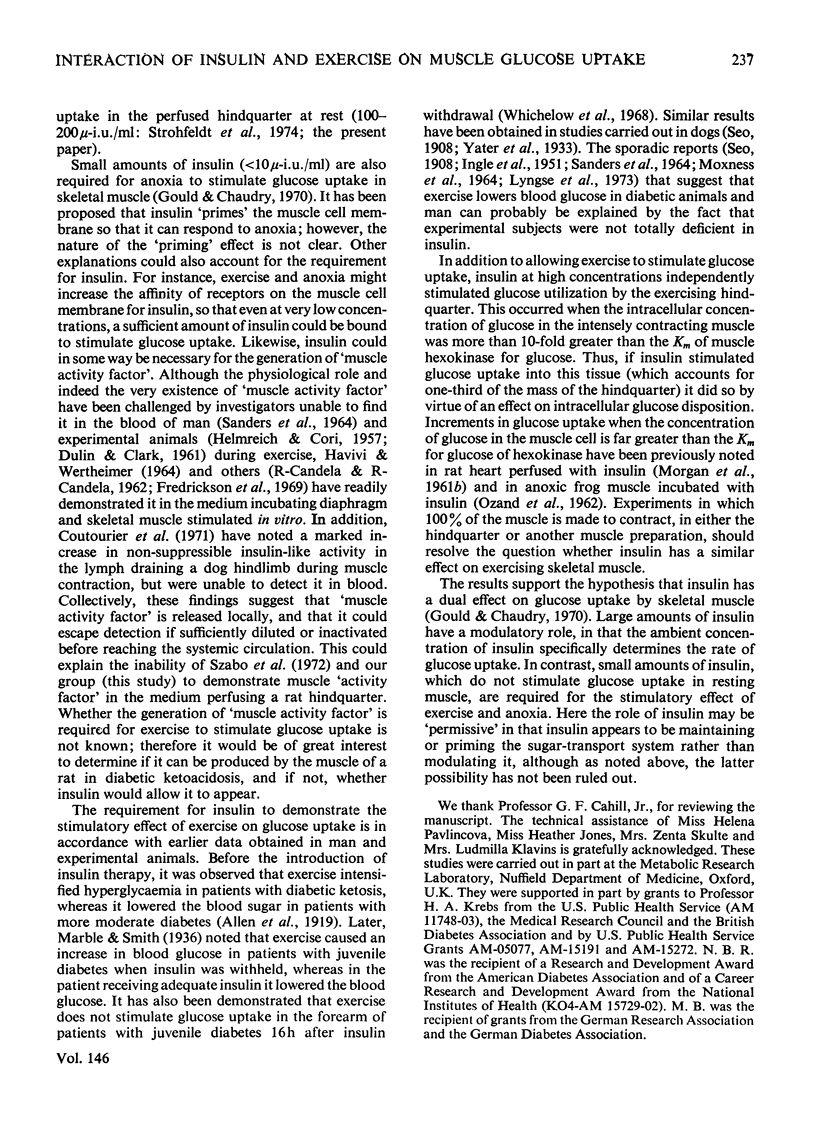
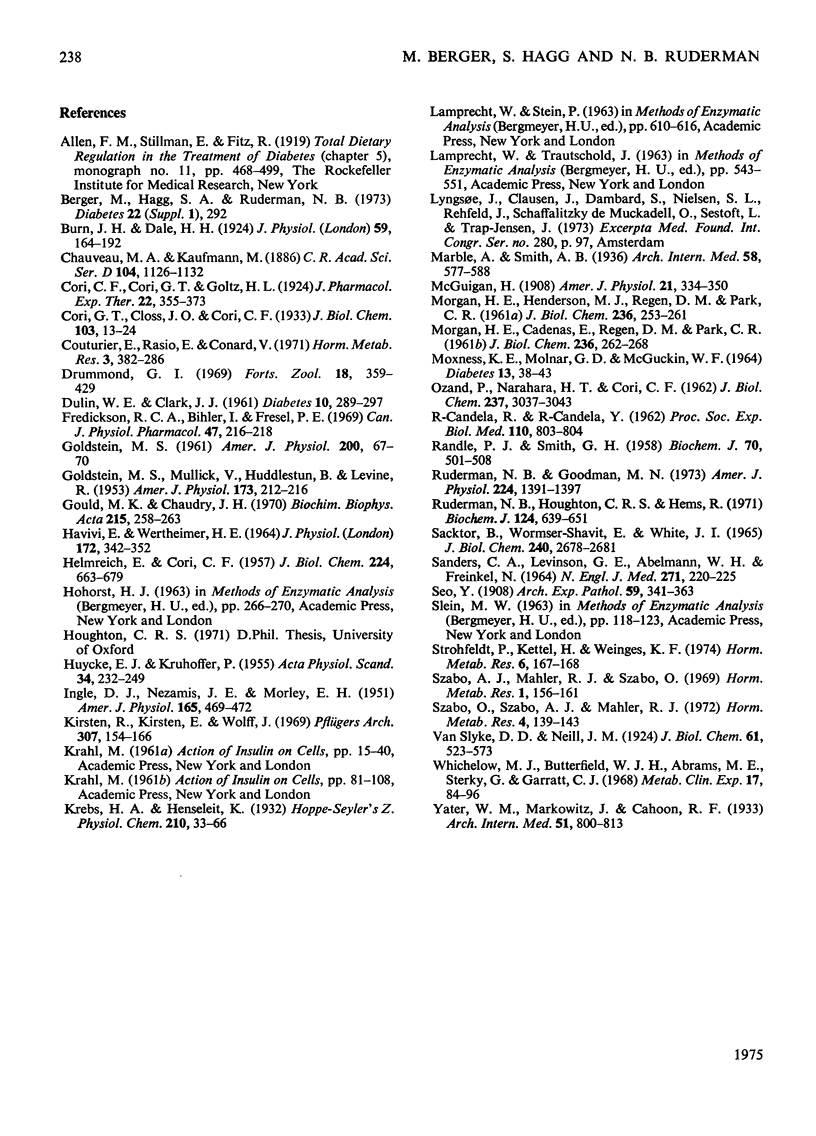
Selected References
These references are in PubMed. This may not be the complete list of references from this article.
- Burn J. H., Dale H. H. On the location and nature of the action of insulin. J Physiol. 1924 Oct 9;59(2-3):164–192. doi: 10.1113/jphysiol.1924.sp002173. [DOI] [PMC free article] [PubMed] [Google Scholar]
- Couturier E., Rasio E., Conard V. Insulin in plasma and lymph and tissue glucose uptake in the exercising hind limb of the dog. Horm Metab Res. 1971 Nov;3(6):382–386. doi: 10.1055/s-0028-1094126. [DOI] [PubMed] [Google Scholar]
- DULIN W. E., CLARK J. J. Studies concerning a possible humoral factor produced by working muscles. Its influence on glucose utilization. Diabetes. 1961 Jul-Aug;10:289–297. doi: 10.2337/diab.10.4.289. [DOI] [PubMed] [Google Scholar]
- Drummond G. I. Muscle metabolism. Fortschr Zool. 1967;18(3):359–429. [PubMed] [Google Scholar]
- Frederickson R. C., Bihler I., Dresel P. E. The effect of muscle activity factor (MAF) on cardiac contractility and sugar transport. Can J Physiol Pharmacol. 1969 Feb;47(2):216–218. doi: 10.1139/y69-038. [DOI] [PubMed] [Google Scholar]
- GOLDSTEIN M. S., MULLICK V., HUDDLESTUN B., LEVINE R. Action of muscular work on transfer of sugars across cell barriers; comparison with action of insulin. Am J Physiol. 1953 May;173(2):212–216. doi: 10.1152/ajplegacy.1953.173.2.212. [DOI] [PubMed] [Google Scholar]
- Gould M. K., Chaudry I. H. The action of insulin on glucose uptake by isolated rat soleus muscle. II. Dissociation of a priming effect of insulin from its stimulatory effect. Biochim Biophys Acta. 1970 Aug 14;215(2):258–263. doi: 10.1016/0304-4165(70)90023-1. [DOI] [PubMed] [Google Scholar]
- HAVIVI E., WERTHEIMER H. E. A MUSCLE ACTIVITY FACTOR INCREASING SUGAR UPTAKE BY RAT DIAPHRAGMS IN VITRO. J Physiol. 1964 Aug;172:342–352. doi: 10.1113/jphysiol.1964.sp007422. [DOI] [PMC free article] [PubMed] [Google Scholar]
- HELMREICH E., CORI C. F. Studies of tissue permeability. II. The distribution of pentoses between plasma and muscle. J Biol Chem. 1957 Feb;224(2):663–679. [PubMed] [Google Scholar]
- HUYCKE E. J., KRUHOFFER P. Effects of insulin and muscular exercise upon the uptake of hexoses by muscle cells. Acta Physiol Scand. 1955 Oct 27;34(2-3):232–249. doi: 10.1111/j.1748-1716.1955.tb01243.x. [DOI] [PubMed] [Google Scholar]
- INGLE D. J., NEZAMIS J. E., MORLEY E. H. Work output and blood glucose values in severely diabetic rats with and without insulin. Am J Physiol. 1951 May;165(2):469–472. doi: 10.1152/ajplegacy.1951.165.2.469. [DOI] [PubMed] [Google Scholar]
- Kirsten R., Kirsten E., Wolff J. The response to ether anesthesia and to electric stimulation of glycolytic metabolites in a red and a white muscle of the rat. Pflugers Arch. 1969;307(3):154–166. doi: 10.1007/BF00592081. [DOI] [PubMed] [Google Scholar]
- MORGAN H. E., CADENAS E., REGEN D. M., PARK C. R. Regulation of glucose uptake in muscle. II. Rate-limiting steps and effects of insulin and anoxia in heart muscle from diabetic rats. J Biol Chem. 1961 Feb;236:262–268. [PubMed] [Google Scholar]
- MORGAN H. E., HENDERSON M. J., REGEN D. M., PARK C. R. Regulation of glucose uptake in muscle. I. The effects of insulin and anoxia on glucose transport and phosphorylation in the isolated, perfused heart of normal rats. J Biol Chem. 1961 Feb;236:253–261. [PubMed] [Google Scholar]
- MOXNESS K. E., MOLNAR G. D., MCGUCKIN W. F. EXERCISE AND BLOOD GLUCOSE CONCENTRATION IN INTACT AND PANCREATECTOMIZED DOGS. Diabetes. 1964 Jan-Feb;13:37–43. doi: 10.2337/diab.13.1.37. [DOI] [PubMed] [Google Scholar]
- OZAND P., NARAHARA H. T., CORI C. F. Studies of tissue permeability. VIII. The effect of anaerobiosis on glucose uptake in frog sartorius muscle. J Biol Chem. 1962 Oct;237:3037–3043. [PubMed] [Google Scholar]
- RANDLE P. J., SMITH G. H. Regulation of glucose uptake by muscle. 2. The effects of insulin, anaerobiosis and cell poisons on the penetration of isolated rat diaphragm by sugars. Biochem J. 1958 Nov;70(3):501–508. doi: 10.1042/bj0700501. [DOI] [PMC free article] [PubMed] [Google Scholar]
- RODRIGUEZ CANDELA R., RODRIGUEZ CANDELA J. L. Possible factor produced during muscular contraction which influences the passage of glucose. Proc Soc Exp Biol Med. 1962 Aug-Sep;110:803–804. doi: 10.3181/00379727-110-27656. [DOI] [PubMed] [Google Scholar]
- Ruderman N. B., Goodman M. N. Regulation of ketone body metabolism in skeletal muscle. Am J Physiol. 1973 Jun;224(6):1391–1397. doi: 10.1152/ajplegacy.1973.224.6.1391. [DOI] [PubMed] [Google Scholar]
- Ruderman N. B., Houghton C. R., Hems R. Evaluation of the isolated perfused rat hindquarter for the study of muscle metabolism. Biochem J. 1971 Sep;124(3):639–651. doi: 10.1042/bj1240639. [DOI] [PMC free article] [PubMed] [Google Scholar]
- SACKTOR B., WORMSER-SHAVIT E., WHITE J. I. DIPHOSPHOPYRIDINE NUCLEOTIDE-LINKED CYTOPLASMIC METABOLITES IN RAT LEG MUSCLE IN SITU DURING CONTRACTION AND RECOVERY. J Biol Chem. 1965 Jun;240:2678–2681. [PubMed] [Google Scholar]
- SANDERS C. A., LEVINSON G. E., ABELMANN W. H., FREINKEL N. EFFECT OF EXERCISE ON THE PERIPHERAL UTILIZATION OF GLUCOSE IN MAN. N Engl J Med. 1964 Jul 30;271:220–225. doi: 10.1056/NEJM196407302710502. [DOI] [PubMed] [Google Scholar]
- Strohfeldt P., Kettl H., Weinges K. F. Perfusion of the isolated rat hindlimb with a synthetic medium. Horm Metab Res. 1974 Mar;6(2):167–168. doi: 10.1055/s-0028-1095704. [DOI] [PubMed] [Google Scholar]
- Szabo A. J., Mahler R. J., Szabo O. Glucose uptake by the isolated perfused rat hind limb during rest and exercise. Horm Metab Res. 1969 Jul;1(4):156–161. doi: 10.1055/s-0028-1095147. [DOI] [PubMed] [Google Scholar]
- Szabo O., Szabo A. J., Mahler R. J. Influence of exercise upon serum factors and its secondary effect on glucose utilization by the resting muscle. Horm Metab Res. 1972 May;4(3):139–143. doi: 10.1055/s-0028-1094087. [DOI] [PubMed] [Google Scholar]
- Whichelow M. J., Butterfield W. J., Abrams M. E., Sterky G., Garratt C. J. The effect of mild exercise on glucose uptake in human forearm tissues in the fasting state and after oral glucose administration. Metabolism. 1968 Jan;17(1):84–95. doi: 10.1016/s0026-0495(68)80010-1. [DOI] [PubMed] [Google Scholar]


